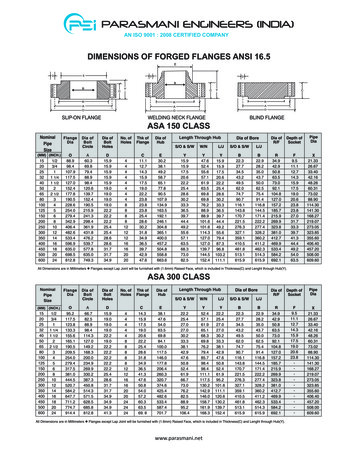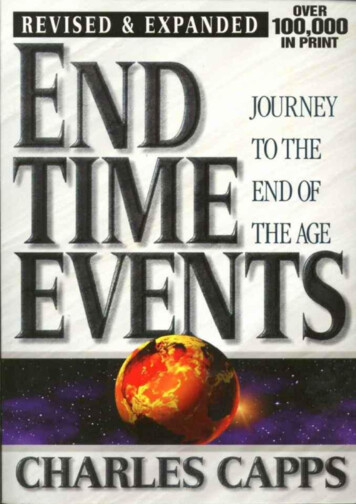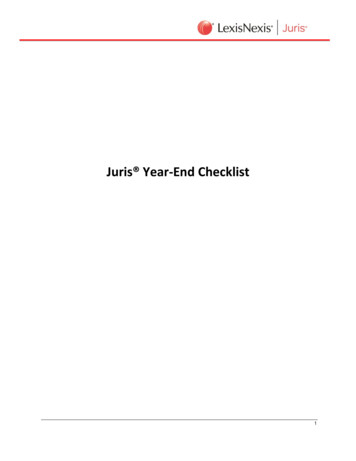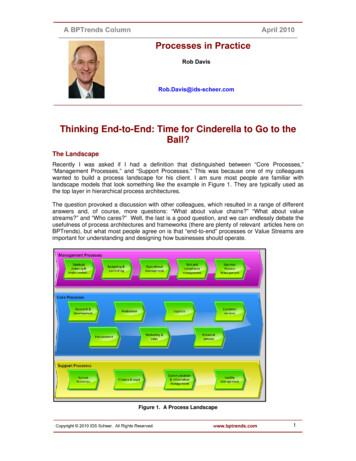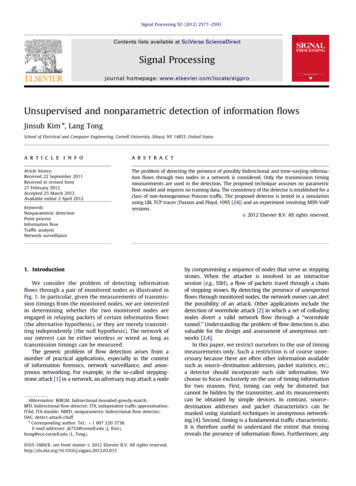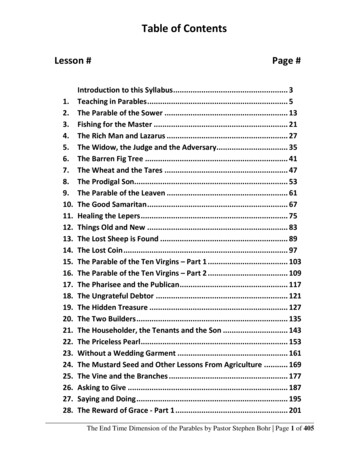
Transcription
Table of ContentsLesson 0.21.22.23.24.25.26.27.28.Page #Introduction to this Syllabus . 3Teaching in Parables . 5The Parable of the Sower . 13Fishing for the Master . 21The Rich Man and Lazarus . 27The Widow, the Judge and the Adversary. 35The Barren Fig Tree . 41The Wheat and the Tares . 47The Prodigal Son. 53The Parable of the Leaven . 61The Good Samaritan . 67Healing the Lepers . 75Things Old and New . 83The Lost Sheep is Found . 89The Lost Coin . 97The Parable of the Ten Virgins – Part 1 . 103The Parable of the Ten Virgins – Part 2 . 109The Pharisee and the Publican . 117The Ungrateful Debtor . 121The Hidden Treasure . 127The Two Builders . 135The Householder, the Tenants and the Son . 143The Priceless Pearl . 153Without a Wedding Garment . 161The Mustard Seed and Other Lessons From Agriculture . 169The Vine and the Branches . 177Asking to Give . 187Saying and Doing . 195The Reward of Grace - Part 1 . 201The End Time Dimension of the Parables by Pastor Stephen Bohr Page 1 of 405
.46.47.48.49.50.51.The Reward of Grace – Part 2 . 207Into the Highways and Hedges . 213The Living Manna . 221The Living Water . 231Judging the Sheep and the Goats. 241The Parable of the Talents - Part I. 249The Parable of the Talents – Part 2 . 255Storms on the Sea . 263Healing the Paralytic at Capernaum. 269The Paralytic at the Pool of Bethesda . 275Gaining to Lose . 285Blindness: Literal and Spiritual . 295Counting the Cost . 303What Defiles a Man . 309Waiting and Watching for the Master . 317The Harvest Principle. 323The Kingdom in Miniature . 331The Strong Man and the Seven Unclean Spirits. 341Seeking Places of Honor . 353The Salt of the Earth . 363The Unfaithful Steward . 371Lambs Among Wolves . 379New Cloth and New Wine. 387Appendix: First Thessalonians 4:14 and The Rapture . 395Abbreviations . 403Contact Information . 405The End Time Dimension of the Parables by Pastor Stephen Bohr Page 2 of 405
Introduction to this SyllabusIn this fifty-one lesson series, we will study the parables as well as some miracles, metaphors andallegories of Jesus. Although I prepared the lessons for the spiritual edification of the individual,they will also prove useful for small group study.Most of the Spirit of Prophecy references come from three classic Christ centered books, Christ’sObject Lessons, Thoughts from the Mount of Blessing and The Desire of Ages. However, asignificant number of quotations come from other Ellen White sources. The table ofabbreviations at the end of the syllabus will help you find these other sources. In lessons 1-44 thebiblical texts are from the King James Version and in lessons 45-51 they are from the New KingJames Version.In order to get the most out of the lessons, it will be necessary to prepare them in advance. Firstread carefully and prayerfully all the passages from Scripture which are given at the beginning ofthe lesson. Next, do the same with the recommended pages from the Spirit of Prophecy. Do notrush thorough the material. Take time to reflect upon what you read.After you carefully read the recommended reading material, you will be ready to prepare thelesson. Please do not simply fill in the blanks. Take time to reflect upon your answers and tointernalize them. Better said, make them a part of your daily life.The lessons cover various types of material. The spoken parables of Jesus are those where Heverbally uttered the parable. His acted parables are those where He performed actions whereHe intended to convey spiritual truth. Many of the miracles of Jesus fit into this category. Forexample, Jesus did not heal the blind, the lepers and the paralytics merely to display His abilityto heal physical disease. Each one of these healings had the greater purpose of teaching deepspiritual truths.We must understand Christ’s non-healing miracles in a parabolic sense as well. Stories such asthe feeding of the five thousand, the miraculous fishing expeditions and the calming of stormscontain a profound spiritual dimension.Besides the verbal and acted parables of Jesus, we will also study some magnificent allegoriessuch as the “Rich Man and Lazarus” and “The Vine and the Branches.”The End Time Dimension of the Parables by Pastor Stephen Bohr Page 3 of 405
Finally, we will notice that most of Christ’s parables, metaphors, allegories and miracles have anend time dimension that speaks to those who live at the close of human history.There are great gems of spiritual truth in the teachings of Jesus. Ellen White has recommended:“Hang in memory’s hall the precious words of Christ. They are to be valued far above silver andgold.” (The Faith I Live By, p. 9)It is my wish that your journey through these lessons will fill your heart with love admiration forthe Master Story Teller and that as you behold the glorious truths of the kingdom “the things ofearth will grow strangely dim in the light of His glory and grace.”The End Time Dimension of the Parables by Pastor Stephen Bohr Page 4 of 405
“The End Time Dimension of the Parables”Lesson #1 - Teaching in ParablesBy Pastor Stephen BohrRecommended Reading: (COL, pp. 17-27; Matthew 13:10-13; Mark 4:11-12; Luke 8:9-10)Today we begin a series of lessons where we will be studying fifty one parables, metaphors,allegories and miracles of Jesus. Though our trek will take us a year, we will find, in the end, thatthe investment of time has paid generous dividends to our spiritual life.In order to get the most out of the lessons, it will be necessary for you prepare them in advance.Please don’t simply fill in the blanks. Reflect upon your answers and internalize them, that is tosay, make them a part of your daily life. There are great gems in the parables of Jesus. Ellen Whitehas recommended: “Hang in memory's hall the precious words of Christ. They are to be valuedfar above silver or gold.” (FLB, p. 9.7)Material to be Studied1.2.3.4.5.6.7.8.9.10.11.12.13.14.15.The Pearl of Great Price (Matthew 13:45-46)The Lost Sheep (Matthew 18:12-14; Luke 15:3-7)The Lost Coin (Luke 15:8-10)The Prodigal Son (Luke 15:11-32)The Barren Fig Tree (Luke 13:6-9; Matthew 21:18-20; Mark 11:14-14; Mark 11:20-21)The Mustard Seed (Matthew 13:31-32; Mark 4:30-32; Luke 13:18-19)The Tares and the Wheat (Matthew 13:24-30; Matthew 13:36-43)The Wicked Husbandmen (Matthew 21:33-43; Mark 12:1-12; Luke 20:9-19)The Sower (Matthew 13:3-9; Matthew 13:18-23; Mark 4:3-20; Luke 8:5-15)The Great Banquet (Luke 14:16-24)The Hidden Treasure (Matthew 13:44)New Cloth and New Wine (Matthew 9:16-17; Mark 2:21-22; Luke 5:36-39)The Two Debtors ( Luke 7:41-43)Building a Tower; A King Going to War (Luke 14:28-33)The Seven Unclean Spirits (Matthew 12:43-45)The End Time Dimension of the Parables by Pastor Stephen Bohr Page 5 of 405
9.50.51.The Two Sons (Matthew 21:28-32)Building on the Rock and on the Sand (Matthew 7:24-27; Luke 6:47-49)The Rich Fool (Luke 12:16-21)The Growing Seed (Mark 4:26-29)The Leaven (Matthew 13:33; Luke 13:20-21)The Wedding Garment (Matthew 22:2-14)The Friend Calling at Midnight (Luke 11:5-13)The Insistent Widow (Luke 18:1-8)Choosing Places of Honor (Luke 14:7-11)The Pharisee and the Publican (Luke 18:9-14)The Nobleman and the Pounds (Luke 19:11-27)The Talents (Matthew 25:14-30)The Dishonest Steward (Luke 16:1-9)The Rich Man and Lazarus (Luke 16:19-31)The Good Samaritan (Luke 10:30-37)The Unforgiving Servant (Matthew 18:21-35)Treasures Old and New (Matthew 13:52)The Faithful Steward (Luke 12:42-48)The Ten Virgins (Matthew 25:1-13)The Watchful Servant (Mark 13:34-37)The Watchful Servant and Vigilant Homeowner (Luke 12:35-40)Laborers of the Vineyard (Matthew 20:1-16)The Unprofitable Servants (Luke 17:7-10)The Sheep and the Goats (Matthew 25:31-46)The Dragnet (Matthew 13:47-50)The Living Manna (John 6:48-51)The Living Water (John 3:5; John 4:10; John 4:13-14; John 7:37-39)Light and Darkness (Matthew 5:14-16; Matthew 6:22-23; John 1:8-9; John 3:19; John8:12; John 9:5; John 12:35-36)Healing Paralytics (John 5:1-15; Matthew 9:1-8; Mark 2:1-12)Healing Lepers (Matthew 8:1-4; Luke 5:12-15)The Man Born Blind (John 9:1-41)Tempests on the Lake (Matthew 8:23-27; Matthew 14:22-33)The Salt of the Earth (Matthew 5:13; Mark 9:49-50; Luke 14:34)Lambs Among Wolves (Matthew 7:15; Matthew 10:16)The Vine and the Branches (John 15:1-9)The transfiguration (Matthew 16:13-17:6)The End Time Dimension of the Parables by Pastor Stephen Bohr Page 6 of 405
Study Methods and Characteristics of Jesus’ Parables1. The Greek word parabole means “putting things side by side.” In other words, it means “tocompare one thing with another.” A parable is a symbolic story whose purpose is to convey onecentral lesson. The individual details of a parable are important but only insofar as they point tothe central truth.2. Many of Jesus’ parables were not original with Him. The rabbis of Christ’s day were actuallyprolific parable tellers. We shall find that Jesus occasionally employed the rabbis’ stories but gavethem an unusual and unexpected twist.3. Most of the parables of Jesus are multidimensional. That is to say, his parables have a localpersonal dimension and a broader universal dimension. We can see two good examples of thisdual meaning of parables in the story of the Good Samaritan and the parable of the Lost Sheep.4. It is important to remember that Jesus employed three types of parables: 1) Verbal parables,metaphors and allegories, 2) Acted parables (such as the cursing of the fig tree), and 3) Miracles.Many fail to realize that Jesus did not perform His works of healing merely to relieve physicalsuffering but also to teach deep spiritual truth. We can see this, for example, in the healing oflepers, blind people and paralytics. We can also discern it in the feeding of the five thousand,three miraculous fishing expeditions and the calming of storms. The woman who touched Jesus’robe is a prime example of a physical healing with deep spiritual implications.5. Bear in mind that we find some of Jesus’ parables in more than one Gospel. In order to get thefull picture, it is necessary to study the parable each time it appears.6. It would be well to remember also that each parable has a very important historical and textualcontext. It is imperative to carefully study the events that transpired before and after eachparable was told.7. Don’t forget that Jesus not only referred to events, people and things which surrounded Himbut He also frequently picked up on themes which are found in the Old Testament. We musttherefore include the Old Testament in our examination of the parables.The End Time Dimension of the Parables by Pastor Stephen Bohr Page 7 of 405
Jesus’ Use of Parables1. In which way was Christ’s parable teaching similar to His own mission? “Christ took ourand dwelt among us. Divinity was revealed in humanity; the invisiblein the visible human form. Men could learn of the through the; heavenly things were revealed through the . . . . So it was inChrist’s . . . .” (COL, p. 17.1)2. Which Old Testament prophecy predicted that Jesus would speak in parables?(Read Matthew 13:34-35 and then check the marginal reference in your Bible. Be sure to studythe entire background chapter in the Old Testament)3. What link existed between the written Word of God and the parables of Jesus? “Natural thingswere the for the spiritual; the things of nature and the life experience of Hishearers were with the truths of the written word. Leading thus from thenatural to the kingdom. . . .” (COL, p. 17.2)4. Why could Jesus employ the lessons of nature so effectively? "In His teaching from nature,Christ was speaking of the things which His own had made, and which had qualitiesand powers that He Himself had .” (COL, p. 18.1)5. What was the original purpose of the created order? “In their original perfection all createdthings were an expression of the of God.” (COL, p. 18.1)6. What striking difference did the people see between Jesus’ teaching and that of the Scribesand Pharisees? “And so it came to pass, when Jesus had ended these sayings, the people wereat His teaching, for He taught them as one having , andnot as the scribes.” (Matthew 7:28-29)Sin’s Effect on Nature1. How did the entrance of sin into the world affect the lessons of nature? “As soon as the holypair transgressed the law of the Most High, the from the of Goddeparted from the face of nature.” (COL, p. 18.1)Note: That is to say, sin damaged the transmitter. After the entrance of sin, nature spokeimperfectly about God. While it still revealed a God of love, it also revealed the contrary principleof evil.2. Did the inception of sin totally obliterate the lessons of nature? “The earth is nowThe End Time Dimension of the Parables by Pastor Stephen Bohr Page 8 of 405
and defiled by sin. Yet even in its state much that isbeautiful remains. God’s object lessons are not ; rightly understood,nature speaks of her Creator.” (COL, p. 18.1)Note: Creation still speaks of God. For this the reason the Psalmist could exclaim: “The heavensdeclare the glory of God; and the firmament shows His handiwork.” (Psalm 19:1)3. What happened with the mind of man because of sin? “In the days of Christ these lessons[from nature] had been lost of. Men had well-nigh ceased toGod in His works.” Paul says that men “became in their , andtheir foolish heart was .” (COL, p. 18.2; Romans 1:21)Note: Not only did sin damage the transmitter but it also damaged the receiver. Man’s unaidedsinful mind could no longer read God’s lessons in nature correctly.4. How is the veil of sin removed from nature and from humanity? “Christ sought to remove thatwhich the truth. The veil that sin cast over the face of , Hecame to draw aside, bringing to view the spiritual glory that all things were created to.” (COL, p. 18.3)5. What two books must we use side by side in the science of education? “The book ofis a great lesson book, which in connection with the weare to use in teaching others of His character, and guiding lost back to God.” (COL, p.24.1)The Purpose for Parables1. What was Jesus’ intended purpose for using parables? “The veil that sin had cast over the faceof , He came to draw aside, bringing to view the glory that allthings were created to reflect. His words placed the teachings of as well as ofthe in a new aspect, and made them a new revelation.” (COL, p. 18.3)2. Why did Jesus choose parables as his preferred method of teaching? “By connecting Histeaching with the scenes of , experience or , He secured theirand impressed their hearts. as they looked upon theobjects that illustrated His lessons, the recalled the words of the divine Teacher.” (COL, p. 21.1)Note: So to speak, Jesus employed a live power point presentation. He knew that a picture isworth a thousand words!The End Time Dimension of the Parables by Pastor Stephen Bohr Page 9 of 405
3. Why did Jesus employ illustrations? “By using a of illustrations, He not onlypresented truth in its different , but appealed to the different.” (COL, p. 21.2)4. What process did Jesus frequently follow as He told His parables? In the parable of the lilies ofthe field, Jesus first “ the beautiful lily. . . . Then followed the sweetand the important .” (COL, p. 19.1) Finally, He spread Hishands and made a call to the multitude, uttering the well-known words found in. (COL, p. 19.2)Note: It is obvious that the parables of Jesus were not only meant to inform. Their main purposewas to lead the people to make a decision in favor of His kingdom.Concealing and Revealing1. Why were the parables of Jesus meant to conceal as well as to reveal? “He presented truth insuch a way that they could find nothing by which to bring His case before the Sanhedrin. Inparables He the hypocrisy and wicked works of those who occupied highpositions, and in language clothed truth of so cutting a character that hadit been spoken in denunciation, they would not have listened to His words,and would speedily have put an end to His ministry.” (COL, p. 22.1)2. What does Matthew 13:11 tell us about the revealing and concealing functions of the parables.“Because it is given unto you to know the of the kingdom of heaven but tothem it is not .”3. Since when had God concealed these mysteries of the kingdom? Jesus stated that thesemysteries that He came to utter, had "been kept from the foundation of theworld." (Matthew 13:35)Note: Several passages from Scripture indicate that these mysteries were directly related to theearthly ministry and mission of Jesus. Revelation 13:8 explains that Jesus is the Lamb of God slainfrom the foundation of the world.4. From whom did Jesus conceal the mysteries of the kingdom and to whom did He reveal them?God revealed these mysteries to the but hid them from the and. (Matthew 11:25; see also Matthew 13:11; Matthew 21:16; Luke 10:21;Psalm 8:2)The End Time Dimension of the Parables by Pastor Stephen Bohr Page 10 of 405
5. What did the apostle Paul have to say about these mysteries? Paul identified these mysterieshidden from the foundation of the world as “the of Jesus Christ. . . . whichwas kept since the world .” (Romans 16:25; see also, Ephesians 1:4;1:9; 3:3; 6:19; Colossians 1:26-27; Revelation 10:7)Nature and the Parables1. In which three ways did Jesus seek to teach the people about God? “He taught them to beholdHim as manifested in His , in His , and by His .” (COL,p. 22.2)2. In what environment can truth best be taught and exemplified? “Christ taught His disciples bythe , on the , in the and , where theycould look upon the things of by which He illustrated His teachings.” (COL, p.23.2)3. What error do teachers frequently commit and how can they correct it? “Too often the mindsof are occupied with theories and speculations, falsely calledscience and philosophy. They need to be brought into contact with nature. Let themlearn that creation and Christianity have God. Let them be taught to seethe of the natural with the spiritual. Let which their eyessee or their hands handle be made a lesson in character building.” (COL, p. 24.2)4. What link exists between the teaching function of the nature and the Sabbath? “On the holyrest day, all other days, we should study the messages that God has written for usin .” (COL, p. 25.1)Note: The Sabbath, in a special sense, reminds us that God is the creator of the heavens and theearth (Exodus 20:11).The Sabbath and nature are closely bound. In fact, the Sabbath should be aspecial day for the contemplation of God through nature.5. How did Jesus connect the teachings of nature with the common labors of everyday life? “Inthe plowing and sowing, the tilling and reaping, He teaches us to see an of Hiswork of in the heart. So in every line of useful labor and every association of life, Hedesires us to find a lesson of truth.” (COL, p. 26.1)The End Time Dimension of the Parables by Pastor Stephen Bohr Page 11 of 405
The End Time Dimension of the Parables by Pastor Stephen Bohr Page 12 of 405
“The End Time Dimension of the Parables”Lesson #2 – The Parable of the SowerBy Pastor Stephen BohrRecommended Reading: COL, pp. 33-61; Matthew 13:24-30; Matthew 13:36-43; Mark 4:1-20;Luke 8:5-15The Field, the Sower and the Soils1. The field in the Parable of the Wheat and the Tares represents the (Matthew13:38).2. The sower represents the of man (Matthew 13:37).3. The soils represent four kinds of hearts where the word of God is planted: “And these are theyby the way side, where the word is sown; but when they have heard, Satan cometh, and taketh away the word that was sown in their .”(Mark 4:15).The Seed1. The seed represents the of God (Luke 8:11).Note: COL, p. 33.1 explains that Jesus’ "parable itself was the seed with which themost precious truths of His grace were ."2. 1 Peter 1:23 explains the meaning of the seed: “Being born again, not of corruptible, but of incorruptible, by the of God, which liveth and abideth for ever.”3. “the same that govern earthly seed sowing govern the sowing of the seeds of. (COL, p. 33.1)The End Time Dimension of the Parables by Pastor Stephen Bohr Page 13 of 405
4. Jesus frequently told parables as the events were occurring. When Jesus told the parable ofthe sower, “upon and both sowers and reapers were busy,the one casting seed and the other harvesting the early grain”. (COL, p. 34.2)5. The life giving power of God’s word can be discerned in the following statement: “Inevery and in every of the word of God is the , thevery life of God, by which the command may be fulfilled and the promise realized. He who byfaith receives the word is receiving the very and character of God.” (COL, p. 38.1)6. It is dangerous to substitute the ideas of men for the word of God because, “Philosophicaltheories or literary essays, however cannot satisfy the ” (COL,p. 40.1)7. The life changing power of God’s word is described in Psalm 119:11 : “Thy have Ihid in mine that I might not against thee.”8. Through the prophet Isaiah (Isa. 55:11), God promises that as the seed bears fruit: “So shall mybe that goeth forth out of my mouth: it shall not return unto me , but itshall accomplish that which I please, and it shall prosper in the thing whereto I sent it.”9. There is grave danger in setting aside the word of God for, “When the word of God is set aside,its power to the evil passions of the natural is rejected. Men sowto the flesh, and of the flesh they reap corruption.” (COL, p. 41.2)10. In many of our schools, the works of the world’s great men are placed before the youngpeople instead of the word of God. The result is that “In turning from God’s word to feed on thewritings of men, the mind becomes and .(COL, p. 41.3)11. Ellen White explains the psychological process whereby the mind is dwarfed and cheapened:“The understanding itself to the comprehension of the things with which it isfamiliar, and in this devotion to things it is weakened, its power is contracted, andafter a time it becomes unable to .” (COL, p. 41.3)12. In many of our schools the study of the Bible is considered of secondary importance. This istragic because, “There is so ennobling and as a study of thegreat themes which concern our eternal life.” (COL, p. 42.1)13. It is not enough to teach the theoretical truths of the word of God. Truth must be embodied.Of Christ it is said: “Christ taught the truth because He the truth. His own thought, HisThe End Time Dimension of the Parables by Pastor Stephen Bohr Page 14 of 405
character, His life-experience, were in His teaching.” (COL, p. 43.1)The Seeds by the Wayside1. “The seed sown by the wayside represents the word of God as it falls upon the heart of anhearer. . . . The spiritual faculties are . Men hear theword, but it not.” (COL, p. 44.2)Note: The wayside represents people who have hearts of stone where it is impossible for theseed of truth to penetrate.2. The birds which plucked the seed away represent the who "taketh away theword out of their hearts lest they should and be .” (Luke 8:12)Note: Concerning this, Ellen White wrote: “As the birds are ready to catch up the seed from thewayside, so is ready to catch away the seeds of divine from the. He fears that the word of God may awaken the careless, and take effect upon theheart.” (COL, p. 44.3)3. Among these inattentive hearers are those who “listen to the preaching of the word of God[and] make it the subject of at home. They sit in on theas they would on the words of a lecturer or a political speaker. . . . Often thesethings are spoken by in the hearing of their own . Thus aredestroyed respect for God’s , and reverence for their message.” (COL, p. 45.1)4. Among the “wayside hearers” was Felix whom, after Paul had preached to him aboutrighteousness, temperance and judgment said to him: “Go thy way for this time, when I have aseason, I will call thee.” (Acts 24:25). That opportunity never came!5. Among the “wayside hearers” was also king Agrippa. After the apostle Paul preached apowerful sermon, the king replied: “ thou persuadest me to be a.” (Acts 26:27-28)6. Among the “wayside hearers” were members of the Sanhedrin who stoned Stephen. We aretold that after they heard Stephen’s message they “ on him with their teeth” andthey “cried out with a loud voice, and their ears, and ran upon him with one.” (Acts 7:54; Acts 7:57)7. In the end-time, many who claim to believe the truth will be “wayside hearers”. Because theydid not or the truth, God will send them a strong delusion thatThe End Time Dimension of the Parables by Pastor Stephen Bohr Page 15 of 405
they might believe the .” (2 Thessalonians 2:9-12)The Seed in Stony Places1. There are two problems with this kind of soil. Luke 8:6 explains that this soil lacked(a symbol of the Holy Spirit). Matthew 13:5-6 underlines the fact that the soilin stony places had “no of earth” and therefore when “the was up”the plant "was .”2. In the people represented by this soil, “ of the natural heart underlies thesoil of their good and .” (COL, p. 46.3)3. “This class may be easily and appear to be bright converts, but theyhave only a religion.” (COL, p. 46.3)Note: These are the people who have a form
dual meaning of parables in the story of the Good Samaritan and the parable of the Lost Sheep. 4. It is important to remember that Jesus employed three types of parables: 1) Verbal parables, metaphors and allegories, 2) Acted parables


